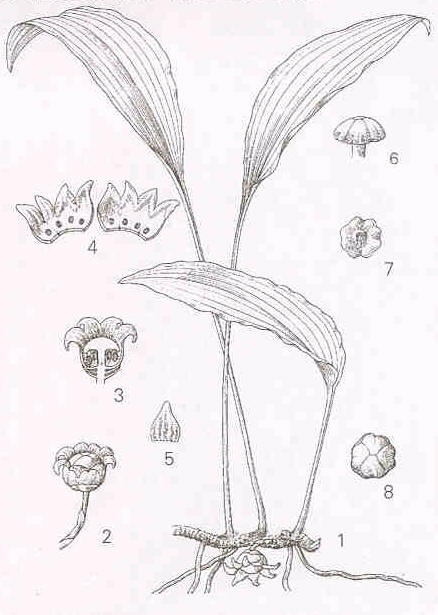.
Aspidistra lurida
| Accepted name | Aspidistra lurida Ker Gawl. Bot. Reg. 8. t. 628. (1822). |
| Synonyms | |
| Distribution | China (Guangdong, NC Guangxi, SC Guizhou) |
| Description | Rhizome: creeping terete, diameter 4 - 10 mm. Leaves: solitary, to ca. 40 cm; cataphylls undescribed; petiole 10 - 15 cm, stiff; lamina narrowly lanceolate, 15 - 22.5 cm long x 3 - 5 cm wide. Peduncle: arching, dark reddish, ca. 3 cm long with ca. 5 bracts; flower solitary, nodding. Perianth [Perigone]: cupular-campanulate, greenish in bud becoming dark purple on maturity; tube ca. 0.5 cm long x 2 cm diameter; lobes 6, ovate-deltoid, ca. 5 mm long x 5 mm wide, adaxially papillose. Stamens: 6 (- 8), inserted proximally in perianth tube, positioned nearly level with stigma, subsessile. Pistil: mushroom-shaped; style columnar at base developed at top into orbicular, 4-lobed stigma strongly convex adaxially, marginal lobes shallow and slightly emarginate, adaxial surface (stigmatic surface) white, abaxial surface white speckled purple, the whole conspicuously filling the mouth of the perianth tube; ovary purple speckled. Fruit: undescribed. Phenology: undescribed. 2n = 36 based on FoC and drawing and photographs in Li Guangzhao 2004 & Sims CBM 51 t 2499 |
| References | Baker 1875, Bois 1896, Chapman & Wang 2002, Chittenden 1951, Coats 1969, Ker Gawler 1822, Rutherford 1990, Sims 1824, Stapf in Wright 1903-05, Stearn 1954, Step 1897, Synge 1969. |
| Comments | not complete Aspidistra lurida is the type of the genus. It was illustrated in Edwards’ botanical register (Ker Gawler 1822) from a plant found at James Colvill’s nursery on the King’s Road, Chelsea (see link below). A plant from the same source was featured later in Curtis’s botanical magazine (Sims 1824) (see link below). Nothing reliable enough to be recorded was known of its date of introduction or origin but A. lurida is now known to be Chinese. The best that can be said about the date of introduction of A. lurida is that it was before 1822. J. D. Parks who collected in China for the Horticultural Society in 1823/4 has been wrongly credited with A. lurida's introduction (e.g. Coats 1969, Chapman & Wang 2002). Parks did not introduce A. lurida but was responsible for introducing the second Aspidistra, A. punctata. In horticulture, the name A. lurida became routinely applied to plants of A. elatior. It is not clear to me why this occurred, as the two have never been synonymous in the botanical literature. J. G. Baker (1875) (see link below) reduced Aspidistra to a single species, A. lurida, by placing A. punctata under it but he reduced A. elatior to a synonym of Plectogyne variegata not A. lurida. In his Atlas des Plantes published in Paris in 1896 Daniel Bois provided an accurate illustration of A. elatior and labelled it as such. However, when the same illustration was published in Edward Step’s Favourite Flowers (Step 1897) to which Bois contributed, the label was changed to A. lurida. This suggests that A. lurida was the more familiar name in England. Otto Stapf (in Wright 1903-05) (see link below) reversed Baker's changes and re-established the three species again (and added a fourth A. minutiflora). Nevertheless, the confusion in horticulture persisted and in the first edition of the RHS Dictionary of Gardening (Chittenden 1951), A. elatior and A. punctata were given as synonyms of A. lurida. This was corrected in the Supplement (Synge 1969) which followed Stapf and accurately summarised the situation as regards A. lurida, A. punctata and A. elatior. Whatever the reason, confusion between A. lurida and A. elatior remains common in horticulture although the flowers are quite distinct. Aspidistra lurida had the advantage of primacy and its discovery at Colvill’s nursery was well advertised but it seems never to have been commonly grown. In 1954 Stearn commented that it was no longer in cultivation; it may have resurfaced in the 1980’s (Rutherford 1990) although Rutherford's comparison of the plants seems a little muddled. Aspidistra lurida remains an obscure plant and despite the recent appearance of the name in nursery lists is difficult reliably to obtain. There is no suggestion that A. lurida is particularly difficult to grow but the dominance of A. elatior in cultivation must presumably be due to its relative speed of growth as well as its larger size (elatior means "taller"). The confusion over names cannot have helped and one can imagine that specimens of "small" A. lurida Ker Gawl. may have been discarded in favour of "large" A. lurida hort. i.e. A. elatior. A. lurida by J. B. Ker Gawler, Bot. Reg. 8. t. 628. (1822) is at
http://www.botanicus.org/page/131551 et seq.
|

